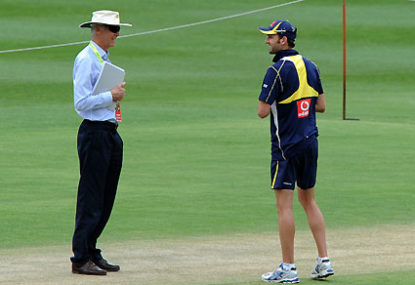Calamitous miss as Lucknow botch near certain run out with the game on the line
With Rajasthan needing 25 off 17, both batsmen ended up at the same end but the bowler dropped the throw from his teammate -…

Process. It’s one of the ubiquitous buzzwords that are associated with modern sport. “We’ve just got to get the process right and the results will follow.”
Well, as far as the National Selection Panel (NSP) and the Australian Test cricket team is concerned, the process is broken and the results are concerning.
A great deal of time and energy has been spent cataloguing instances (real or perceived) of flawed process in picking Australia’s best Test XI.
Be it the pre-Ashes super-squad named by the Andrew Hilditch-chaired NSP, the apparent fixation on all-rounders, the lack of red-ball cricket opportunities afforded to Usman Khawaja in the early part of 2013 or the ‘informed player management’ system preferred by the NSP and general manager of team performance, Pat Howard.
With both eyes firmly fixed upon the upcoming Ashes tour, it’s critical that the NSP gets the process right. So, what is that process?
The key is patience. Australia’s tour of England commences on 26th June, with the first Test starting on 10th July. There is no need to name a full squad of 16 or 17 in the coming days.
The NSP may be inclined to do so on the basis that naming a squad well in advance of the Tour creates the perception of certainty.
That may have been the case when Australia’s best XI was set in stone, but after observing the revolving door policy applied in India it is clear that the best XI, or even a preferred XI, is far from settled.
Instead, the NSP should tell us what we already know. There are 11 players who are locked in to tour.
They are (in batting order) Ed Cowan, David Warner, Phil Hughes, Shane Watson, Michael Clarke, Matthew Wade, Mitchell Starc, James Pattinson, Peter Siddle and Nathan Lyon, with Brad Haddin travelling as reserve wicket keeper.
I should note, I’m not advocating selection of any of these players, I’m simply noting the clear preferences of the NSP.
Observing the statements of NSP chair, John Inverarity, one could also infer that Ryan Harris has done enough to book his ticket without any need for further audition.
Accordingly, the NSP should name these 13 players as the core of Australia’s touring party.
The NSP should then use the Australia A tour of Scotland, Ireland and England (Gloucestershire) for its proper purpose, to test the ability and form of players on the fringe of national selection.
By all means, focus on youth. But pick cricketers who can fill the remaining four or five places on the Ashes tour.
Those names must include Usman Khawaja, Steve Smith, Moisés Henriques and Jackson Bird who were on Australia’s tour of India.
Glenn Maxwell and newly contracted James Faulkner will almost certainly be part of Australia’s ICC Champions Trophy team and will not be available for selection.
The balance of the touring party should be made up of the players who are so frequently discussed as potential Test players.
Players like: Jordan Silk, Alex Doolan, Joe Burns, Tim Paine, Chris Hartley, Steven O’Keefe, Ashton Agar, Ben Cutting, Nathan Coulter-Nile, Gurinder Sandhu, and Chad Sayers.
The players who, in the eye of the NSP, perform well on the Australia A tour should join the Test tour after the final Australia A match concludes on 23 June.
Adopting such a selection strategy makes it clear to both the players and the public what is required for selection – runs and wickets in the second XI.
Or, to phrase it in a manner suitable for publication in a Cricket Australia press release, the utilisation of the prevailing selection criteria provides transparency to all stakeholders.
Finally, when making selection decisions, the NSP should consider both pedigree and results. Which is code for ‘if Chris Rogers is averaging 70 for Middlesex come mid-June, pick him!’